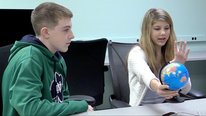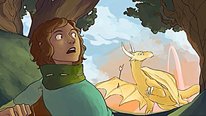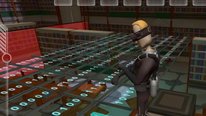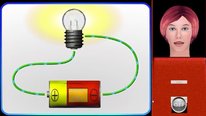WENDY MARTIN
Digital Games as Analogical Sources for Science Learning
NSF Awards: 1252382
How can we help teachers leverage students’ interest in digital games to enhance science instruction? This video presents a project that investigates whether analogy mapping is an effective technique for helping middle school students learn challenging science concepts. Using recordings of classroom instruction, interviews with researchers and teachers, this video explores the digital games and instructional technique while explaining the research planning and implementation.
Digital Games as Analogical Sources for Science Learning
NSF Awards: 1252382
How can we help teachers leverage students’ interest in digital games to enhance science instruction? This video presents a project that investigates whether analogy mapping is an effective technique for helping middle school students learn challenging science concepts. Using recordings of classroom instruction, interviews with researchers and teachers, this video explores the digital games and instructional technique while explaining the research planning and implementation.
-
 EcoXPT: Simulated Experimentation in Ecosystems
EcoXPT: Simulated Experimentation in Ecosystems
Shari Metcalf
-
 GRASP (Gesture Augmented Sims for Supporting Explanations)
GRASP (Gesture Augmented Sims for Supporting Explanations)
Robb Lindgren
-
 SimScientists Assessments: Physical Science Links
SimScientists Assessments: Physical Science Links
Matt Silberglitt
-
 Geniverse: Online Genetics Experimentation... with Dragons
Geniverse: Online Genetics Experimentation... with Dragons
Chad Dorsey
-
 Engage
Engage
James Lester
-
 MyST: Children's conversations with a virtual science tutor
MyST: Children's conversations with a virtual science tutor
Ronald Cole
6852 Views
Continue the discussion of this presentation on the Multiplex. Go to Multiplex
6852 Views
Related videos you might be interested in...
-
 EcoXPT: Simulated Experimentation in Ecosystems
EcoXPT: Simulated Experimentation in Ecosystems
Shari Metcalf
-
 GRASP (Gesture Augmented Sims for Supporting Explanations)
GRASP (Gesture Augmented Sims for Supporting Explanations)
Robb Lindgren
-
 SimScientists Assessments: Physical Science Links
SimScientists Assessments: Physical Science Links
Matt Silberglitt
-
 Geniverse: Online Genetics Experimentation... with Dragons
Geniverse: Online Genetics Experimentation... with Dragons
Chad Dorsey
-
 Engage
Engage
James Lester
-
 MyST: Children's conversations with a virtual science tutor
MyST: Children's conversations with a virtual science tutor
Ronald Cole

Wendy Martin
Research Scientist
Thanks for viewing this video! Because we needed to keep the video short, and we wanted to show more of the teacher and students than the researchers talking, you may want more details about the study, or the instructional techniques, or the games. My colleagues and I are happy to share what we’re learning with you and answer whatever questions you may have.
Richard Hudson
Senior Executive Producer
Very nicely captured classroom instruction and student involvement. It’s challenging video production and well done here. Tell us more about “analogy mapping.” What other concepts might this technique be applied to?
Wendy Martin
Research Scientist
Thanks for your question, Richard. The analogy mapping techniques we are studying were actually described by Richland, Zur, & Holyoak (2007) in their study of effective mathematics instruction across different cultures, using TIMSS videos. Lindsey Richland, one of the authors of that article, is an advisor on this project and has been enormously helpful in providing guidance on the use of the techniques as well as our analysis. An important element of analogy mapping is that it uses visual supports like images and gestures to help students see the relationships between the source (the familiar thing, which in this case is the game) and the target (the science concept, which in the video is the idea that the sun’s energy breaks apart molecules into atoms that then form new molecules). This study is looking at the use of these techniques to teach energy transfer as it relates to photosynthesis, heat transfer, and electricity.
Richard Hudson
Senior Executive Producer
Your video captures some nice moments where we see the students gesturing between the different images. That physical connection to cognition is fascinating!
Victor Mateas
These games seem very engaging and educative! Are the games and instructional materials available online? Where can they be found? Also are the materials developed only for middle school / do you have plans to extend to other grade levels?
Wendy Martin
Research Scientist
Hi Victor;
The games were developed under a grant from the US Department of Education and are available for free at the site possibleworlds.edc.org. There are a lot of instructional materials there now, but not the PowerPoints that we’re using in the study. Those we hope to add to the Possible Worlds site after the study is completed. The materials are for middle school, but I think the games and other materials could be adapted for older kids.
Robert Tinker
I’m glad you are focusing on deriving learning from models and games. What can seem so obvious to teachers and authors, can be baffling to kids. I’m still not clear about ‘analogy mapping’ but it sounds like a way to engage kids in making good connections between science and models.
Marian Pasquale
As you know, teachers use analogies regularly to help students understand a difficult concept. Analogy mapping is a strategy that makes the best use of an analogy. Using a visual of the science concept, such as a cell and one for the analogy, such as the buildings in a city, teachers can point between the analogy idea (city hall)and the science idea (nucleus) to make a better connection for their students.
Jerry Valadez
CEO
I had the same question about analogy mapping, and glad to see the explanation above. I am curious about the teacher preparation that goes into the study. How are teachers prepared to moderate while students are engaging with the games? Are there specific prompts developed to guide students, and their thinking while on the program? I’ve seen students sometimes taking this type of game on as a speed challenge.
Marian Pasquale
Jerry,teachers had one day of PD to get an over view of the project, play the games, review the science in them and learn about implementation. After that we had a webinar for each game as a review and to help prep teachers for their implementation.
Wendy Martin
Research Scientist
Also, we included question prompts, along with game animations in powerpoints that we gave to teachers to use at two different occasions. 1. in a debrief discussion after the students played the game the first time, and 2. in a discussion they would have then after they had instruction on the science concept and played the game a second time. It was during this second discussion that teachers and students would map the game analogies to the science concepts.
Wendy Martin
Research Scientist
Thanks for your comment Bob. In this study we have students play the game for a class period, and then in another class period the teachers project the game animations alongside more standard images of the science topics and talks about how they are related. This really gives the students and teachers time to talk through the ideas and build an understanding of how processes they played around with in the game are analogous to science processes. The fact that the conversation is grounded on something fun, and something that many of them had a chance to become skillful at, gives them an entry point for making relational connections to science concepts that are often challenging.
Peter Orne
This video does a great job showing student work and engagement!
Wendy Martin
Research Scientist
Thanks Peter. It was really exciting to see how excited students were to talk about the games and make the connections between the concept and what they did in the games.
Further posting is closed as the showcase has ended.